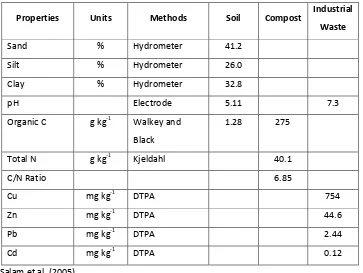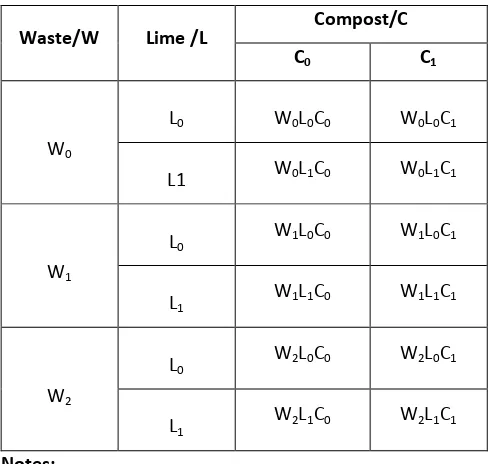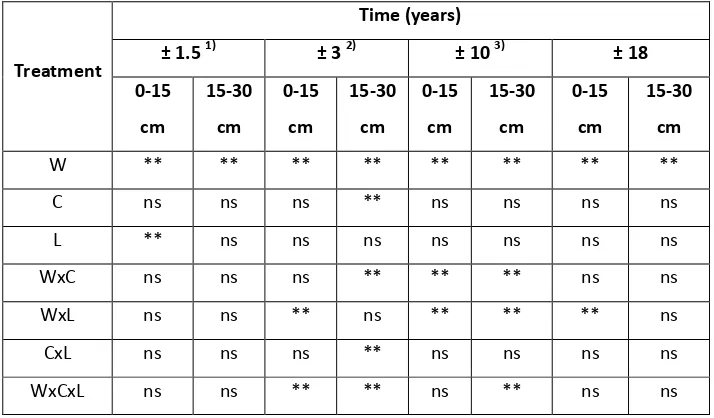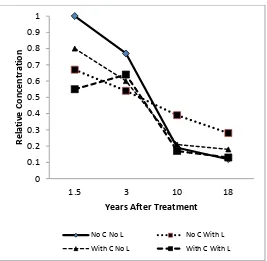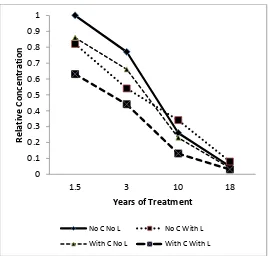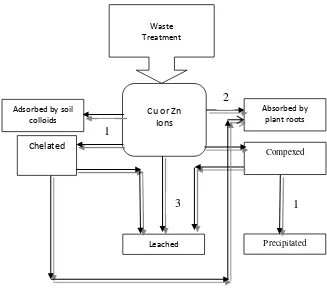Residues of Cu and Zn in Tropical Soil Over 18 Years after Treatment with Cu- and Zn-
Containing Waste, Lime, and Compost
Abdul Kadir Salam
Department of Soil Science University of Lampung Indonesia
Abstract
Heavy metals are believed to be retained in soils for decades and some soil amendments may strengthen their retainment. This research was intended to evaluate the changes in the extracted Cu and Zn in a tropical soil over about 18 years after treatment with Cu- and Zn-containing waste, dolomite, and cassava-leaf compost. Soil samples were taken at about 1.5, 3, 10, and 18 years after treatments. Treatment plot was set in 1998 and was factorially treated with a metal-spoon industrial waste at rates of 0, 15, and 60 ton ha-1, lime at 0 and 5 ton ha-1, and compost at 0 and 5 ton ha-1. The results show that the significant increases in Cu and Zn in topsoil and subsoil caused by waste addition were observed over 18 years after treatment. The increase in pH by lime was observed over 10 years but its effect on the extracted Cu and Zn was observed only at 1.5 years, particularly in topsoil. However, the effect of lime was observed over 18 years when waste was also given. Similarly, the effect of compost was absent over 18 years, but was significant when waste and/or lime were also given. The relative concentration of Cu and Zn decreased over 18 years and their concentrations were in general lower with lime and/or compost treatment.
Keywords: Copper, Residue, Retainment, Tropical Soil, Waste, Zinc
Introduction
the soil pH values. Adjusting the tropical soil pH to higher values may enhance the soil retainment capacity towards heavy metals. A great deal of researchers have previously reported that the heavy metal retaiment increases with the increase in soil pH (Salam and Helmke, 1998; He et al., 2006; Khan and Jones, 2008; Elbana and Selim, 2010; Mahar et al., 2015; Malinowska, 2017). He et al. (2006) shows that the leached Zn from sandy soils decreased linearly as the solution pH was raised from 3.0 to 9.0. Later, Elbana and Selim (2010) also report that Cd was nearly immobile in a column of calcareous soils but 20 – 30% of the applied Cd was mobile in acid soils. Salam et al. (2005) show that both Cu and Zn are shifted to the higher energy bonding in limed soils. Under limed condition, the heavy metals Cu and Zn are leached in smaller amount than those of under control conditions The enhanced heavy metal retainment may be attributed to more intensive adsorption reaction due to the presence of more adsorptive surfaces (Salam and Helmke, 1998; Bhattacharyya and Gupta, 2008; Namgay et al., 2010; Mamindy-Pajany et al., 2014; Gonzalez-Costa et al., 2017). Increasing the tropical soil pH may enhance the soil negative charges due to the increased dissociation of surface charged H on soil clays and oxides that may finally adsorb heavy metal cations and decrease their mobility (Bolan et al., 2014; Malinowska, 2017). The enhanced soil retainment capacity may also be attributed to the more intensive precipitation reaction (Bolan et al., 2014; Salam, 2017), particularly at high pH and soil solution concentrations of heavy metals.
acidification may increase heavy metal release and mobility (Wang et al., 2009; Park et al., 2013; Bolan et al., 2014). Therefore, lime and organic matter may greatly lower the soil labile fractions in heavy metal contaminated or heavy metal treated soils.
However, the enhanced retainment of heavy metals by soil clays, organic matter, and lime may elapse with time. Soil acidification may reverse the reaction and shift the adsorbed heavy metals to lower energy sites or release them into the soil water moving in soil body. Organic matter may decompose and, similarly, release heavy metals into the soil water moving in soil body. Overall, the status of heavy metals in soils is time dependent and is influenced by the soil environment properties like soil temperature, pH, microbial and enzymatic activities, soil water, water percolation, and element leaching. Cui et al. (2016) show that soil amendments to reduce the soil labile pools of heavy metals were not sustained for long time. They found that apatite had a better sustainable effect on the remediation of heavy-metal contaminated soils than did lime and charcoal.
Data on the retainment of heavy metals in soils of the tropics with high average temperature and precipitation rates are rare. This research was intended to evaluate the extracted Cu and Zn in a heavy metal contaminated tropical soil amended with organic matter compost and lime over the last 18 years since treatment.
Materials and Methods
Soil samples were taken from the experimental plots set in July 1998, located in Sidosari, Natar, South Lampung, Indonesia (…). Treatments were previously set in a randomized block design, consisted of 3 factors: industrial waste, lime, and cassava-leaf compost, with 3 replications. Industrial waste was metal-spoon industry of PT Star Metal Wares Jakarta containing high Cu and Zn. Some properties of the industrial waste were Cu 754 mg kg-1, Zn 44.6 mg kg-1, Pb 2.44 mg kg-1, Cd 0.12 mg kg-1, and pH 7.30 as shown in Table 1 (Salam et al., 2005).
Industrial waste was broadcasted on the surface of soil and mixed thoroughly by plowing at 0 – 15 cm at rates: 0, 15, and 60 ton ha-1. Lime and cassava-leaf compost were both given at 0 and 5 ton ha-1 one week after waste treatment. Lime was (CaMg(CO3)2). Casava-leaf compost was prepared as reported by Salam (2000). Rates of industrial waste, lime, and cassava-leaf compost were selected through several preliminary experiments reported previously (Salam, 2001). Each plot measured 4.5 m long and 4 m wide, with distances 50 cm between plots and 100 cm between blocks. Complete experimental treatments are listed in Table 2. The experimental plots were since 1998 planted with corn, dryland paddy, cassava, peanut, and left bare in between.
Insert Table 2
The lattest soil sampling was conducted on 17 September 2016 ((±18 years after treatment). Composite topsoil (0-15 cm) and subsoil (15-30 cm) samples were taken diagonally from 5 points in each plot. Soil samples were air-dried, ground to pass a 2-mm-sieve, and mixed thoroughly before analysis. Analysis included soil Cu and Zn labile fraction with DTPA method (Baker and Amacher, 1987) and soil pH with a pH electrode. For the purpose of this research, this data was compared to those of ±1.5 years after treatment (Amirulloh, 2000), ±3 years after treatment (Prihatin, 2002), and ±10 years after treatment (Ginanjar, 2009).
Results and Discussion
retaining part of heavy metals for a quite long time. As indicated by Bolan et al. (2013), Park et al. (2013), and Salam (2017), the leaks of Cu and Zn through heavy metal leaching and plant absorption were also probable. However, it is reported that the movement of Cu and Zn in the soil body over 3 years period was not significant and was lower in limed soils (Salam et al., 2005). The heavy metal adsorption onto higher energy bonding with time was very probable.
Insert Table 3 and Table 4
Even though reported to increase the soil retainment capacity towards heavy metals, particularly right after treatment (Amirulloh, 2000; Salam, 2000), organic compost did not affect the retainment of Cu and Zn after long time (Tables 3 and 4). This phenomenon was obviously caused by the probable quick decays of organic matter over time, particularly in the tropics where the relatively high moisture content may accelerate the enzymatic organic matter decomposition (Salam, 2014). The decomposition process of organic matter may lower its effectiveness in decreasing the extracted Cu and Zn. Based on their researches, Bendfeldt et al. (2001) report that organic matter incorporation is indeed useful to retain part of heavy metals in mine soils, but they suggest that the decomposition organic matter by soil microorganisms may cause the release of heavy metals to more readily available forms in the future. It is also reported that the oxidation of soils with dilute H2O2 significantly decreased Cu and slightly decreased the adsorbed Zn onto organic substances (Stietiya and Wang , 2011). Organic matter decomposition may then in general increase the Cu and Zn mobilities and availabilities. More durable organic matter materials like biochars may probably give more significant effect over a longer time of process (Namgay et al., 2010).
of OH- at higher pH by lime may detach bonded H on the organic matter functional groups causing the increase in the adsorption sites that are important for heavy metal adsorption.
Insert Table 5
The extracted Cu and Zn as affected by lime and/or cassava-leaf compost and time of sampling in plots with the highest waste addition of 60 ton ha-1 are also shown in Fig. 1 and Fig. 2, respectively, presented as the relative concentrations calculated by Equation 1.
RM = ……. Eq. 1
where RM is the relative concentration of heavy metal M, M is the extracted heavy metal M, and M0.1.5 is the extracted heavy metal M in the control plot (No-Compost and No-Lime), which equaled to 122 mg kg-1 for Cu and 116.6 for Zn at waste addition of 60 ton ha-1. This data is needed to evaluate the trend of heavy metal immobilization over time as affected by lime, compost, and waste treatment.
Insert Fig. 1
Insert Fig. 2
Fig. 1 clearly shows that the RCu decreases with time of sampling. For example, the RCu at
, , and years are 1.00, 0.77, and 0.19, respectively (Fig. 1). A similar pattern was observed for Zn (Fig. 2). RZn decreases with time of sampling. These values indicate that the extracted Cu and Zn decrease with time. Some of the Cu and Zn was removed from their labile pools and was shifted to other forms over time. Several probabilities are depicted in Fig. 3. A part of Cu or Zn was probably adsorbed into a higher energy adsorption sites or precipitated to a more insoluble precipitates. The other parts may be absorbed by plants or leached through the soil bodies (Bolan et al., 2013; Park et al., 2013; Salam, 2017).
At earlier time i.e. at 1.5 and 3 years, the role of lime and/or cassava-leaf compost is obvious. The extracted Cu (Fig. 1) and Zn (Fig. 2) were depressed by lime and/or cassava-leaf compost. The organic matter enhanced the soil capacity to retain heavy metal cations as negatively charged functional groups (Poonia and Deka, 2001; Khan and Jones, 2008; Gupta and Nayak, 2012; Mahar et al., 2015; Khaledian et al., 2017; Pukalchik et al., 2017) and the raised pH by lime enlarged the quantity of the negatively charged organic matters and soil clays (Salam and Helmke, 1998; Khan and Jones, 2008; Mahar et al., 2015; Malinowska, 2017) that are able to retain more Cu and Zn cations. However, the role of these factors faded with time of sampling more than 3 years. After 3 years the presence of compost solubilized Cu and Zn. However, the interaction of lime and compost in the presence of waste were observe to lower the extracted Cu and Zn.
Heavy metals released into the soil solution after 3 years may have encountered various fates as suggested by Bolan et al. (2013), Park et al. (2013), and Salam (2017) shown in Fig. 3. However, Salam et al. (2005) show that after 3 years Cu and Zn were leached in smaller amount than those under control conditions but overall the Cu and Zn were not significantly moved to subsoils. Most of the heavy metals may have been adsorbed onto the higher energy sites.
Acknowlegment
This research was partially supported by the research funding provided by The Directorate General of Higher Education The Department of National Education through Competitive Research Grant Fiscal Year of 1995-1999, “Hibah Kompetitif Penelitian Sesuai Prioritas
Nasional” in the Fiscal Year of 2009, and The University of Lampung.
Adamczyk-Szabela, D., J. Markiewicz, and W. M. Wolf. 2015. Heavy metal uptake by herbs. IV. Influence of pH on the content of heavy metals in Valeriana officinalis L. Water Air Soil Pollut. 226(4):106.
Amirulloh. 2000. Tinggalan Unsur Mikro Kelompok Logam Berat Asal Limbah Industri dalam Tanah yang Telah Diperlakukan dengan Kapur dan Kompos Daun Singkong. Skripsi. Fakultas Pertanian Universitas Lampung, Bandar Lampung. (In Indonesian).
Baker, D.E. and M.C. Amacher. 1987. Nickel, copper, zinc, and cadmium. pp.323-336. In A.L. Page, R.H. Miller, and D.R. Keeney (Eds.). Methods of Soil Analysis Part 2 Chemical and Microbiological Properties. 2nd ed. SSSA Inc., Madison.
Bendfeldt, E.S., J.A. Burger, and W.L. Daniels. 2001. Quality of amended mine soils after sixteen years. Soil Sci. Soc. Am. J. 65:1736-1744.
Bhattacharyya, K.G. and S.S. Gupta. 2008. Adsorption of a few heavy metals on natural and modified kaolinite and montmorillonite: a review. Adv. Coll. Interface Sci. 140(2):114-131. Bolan, N., A. Kunhikhrisnan, R. Thangarajan, J. Kumpiene, J. Park, T. Makino, M.B. Kirkham, and K. Scheckel. 2013. Remediation of heavy metal(loid)s contaminated soils – to mobilize or to immobilize? J. Hazardous Materials 266:141-166.
Cui, H., Y. Fan, L. Xu, J. Zhou, D. Zhou, J. Mao, G. Fang, L. Cang, and Z. Zhu. 2016. Sustainability of in situ remediation of Cu- and Cd-contaminated soils with one-time application amendments in Guixi, China. J. Soils Sediments 16(5):1498-1508.
Elbana, T.A. and H.M. Selim. 2010. Cadmium transport in alkaline and acidic soils: miscible displacement experiments. Soil Sci. Soc. Am. J. 74:1956-1966.
Gonzalez-Costa, J.J., M.J. Reigosa, J.M. Matias, and E. Fernandez-Covelo. 2017. Analysis of the importance of oxides and clays in Cd, Cr, Cu, Ni, Pb, and Zn adsorption and retention with regression trees. https://doi.org/10.1371/journal.pone.0168523.
Gupta, V.K. and A. Nayak. 2012. Cadmium removal and recovery from aqueous solutions by novel adsorbents prepared from orange peel and Fe2O3 nanoparticles. Chem. Eng. J. 180:81-90. He, Z.L., M. Zhang, X.E. Yang, and P.J. Stoffella. 2006. Release behavior of copper and zinc from sandy soils. Soil Sci. Soc. Am. J. 70:1699-1707.
Khaledian, Y., P. Pereira, E.C. Brevik, N. Pundyte, and D. Paliulis. 2017. The relationship between TOC and pH with exchangeable heavy metal levels in Lithuanian Podzols. Conf. 19th EGU General Assembly p. 128. Viena 23-28 April 2017.
Khan, M.J. and D.L Jones. 2008. Chemical and organic immobilization treatments for reducing phytoavailability of heavy metals in copper-mine tailings. J. Plant Nutr. Soil Sci. 171(6):908-916.
Li, B., J. Yang, D. Wei, S. Chen, J. Li, and Y. Ma. 2014. Field evidence of cadmium phytoavailability decreased effectively by rape straw and/or red mud with zinc sulphate in a Cd-contaminated calcareous soil. https://doi.org/10.1371/journal.pone.0109967.
Mahar, A., P. Wang, R. Li, and Z. Zhang. 2015. Immobilization of lead and cadmium in contaminated soil using amendments: a review. Pedosphere 25(4):555-568.
Malinowska, E. 2017. The effect of liming and sewage sludge application on heavy metal speciation in soil. Bull. Environ. Contam. Toxicol. 98(1):105-112.
Mamindy-Pajany, Y., S. Sayen, J.F.W. Mosselmans, and E. Guillon. 2014. Copper, nickel, and zinc speciation in biosolid-amended soil: pH adsorption edge, -XRF and -XANES investigations. Environ. Sci. Technol. 48(13):7227-7244.
Namgay, T., B. Singh, and B.P. Singh. 2010. Influence of biochar application to soil on the availability of As, Cd, Cu, Pb, and Zn to maize (Zea mays L.). Aust. J. Soil Res. 48(7):638-647. Park, H., K. Jung, R.D. Alorro, and K. Yoo. 2013. Leaching behavior of copper, zinc, and lead from contaminated soil with citric acid. Materials Transactions. 54(7):1220-1223.
Poonia, S.R. and A.K. Deka. 2001. Effect of farmyard manure on relative sorption of copper, zinc, cobalt, and cadmium in soils from semi-arid and humid regions of India. Plant Nutrition 92:482-483.
Pukalchik, M., M. Panova, M. Karpukhin, O. Yakimenko, K. Kydralieva, and V. Terekhova. 2017. Using humic products as amendment to restore Zn and Pb polluted soil: a case study using rapid screening phytotest endpoint. J. Soils Sediments. https://doi.org/10.1007/s11368-017-1841-y.
Prihatin, F. 2002. Pengaruh Tinggalan Limbah Industri, Kapur, dan Kompos Daun Singkong terhadap Ketersediaan Cu dan Zn pada Beberapa Kedalaman Tanah Ultisol Sidosari Natar Lampung Selatan. Skripsi. Fakultas Pertanian Universitas Lampung, Bandar Lampung. (In Indonesian).
Salam, A.K. and P.A. Helmke. 1998. The pH dependence of free ionic activities and total dissolved concentrations of copper and cadmium in soil solution. Geoderma 83:181-291.
Salam, A.K. 2000. A four year study on the effects of manipulated soil pH and organic matter contents on availabilities of industrial-waste-origin heavy metals in tropical soils. J. Tropical Soils. 11:31-46.
Salam, A.K., S. Bakrie, and F. Prihatin. 2005. Depth-wise distribution of extracted Cu and Zn in cultivated field-plots three years after treatment with a Cu- and Zn-containing waste, lime, and cassava-leaf compost. J. Tropical Soils. 11:9-14.
Stietiya, M.H. and J.J. Wang. 2011. Effect of organic matter oxidation on the fractionation of copper, zinc, lead, and arsenic in sewage sludge and amended soils. J. Environ. Qual. 40:1162-1171.
Tang, W.W., G.M. Zeng, J.L. Gong, J. Liang, P. Xu, C. Zhang, and B.B. Huang. 2014. Impact of humic/fulvic acid on the removal of heavy metals from aqueous solution using nanomaterials: a review. Sci. Total Environ. 468-469:1014-1027.
Tokunaga, T.K., J. Wan, M.K. Firestone, T.C. Hazen, K.R. Olson, D.J. Herman, S.R. Sutton, and A. Lanzirotti. 2003. In situ reduction of chromium (VI) in heavily contaminated soil through organic carbon amendment. J. Environ. Qual. 32:1641-1649.
Table 1. Selected properties of soil, compost, and industrial waste used in the experiment.
Properties Units Methods Soil Compost Industrial
Waste
Sand % Hydrometer 41.2
Silt % Hydrometer 26.0
Clay % Hydrometer 32.8
pH Electrode 5.11 7.3
Organic C g kg-1 Walkey and
Black
1.28 275
Total N g kg-1 Kjeldahl 40.1
C/N Ratio 6.85
Cu mg kg-1 DTPA 754
Zn mg kg-1 DTPA 44.6
Pb mg kg-1 DTPA 2.44
Cd mg kg-1 DTPA 0.12
Table 2. The existing treatment units in the experimental plots at Sidosari, Natar, Lampung, Indonesia.
Waste/W Lime /L
Compost/C
C0 C1
W0
L0 W0L0C0 W0L0C1
L1 W0L1C0 W0L1C1
W1
L0
W1L0C0 W1L0C1
L1
W1L1C0 W1L1C1
W2
L0
W2L0C0 W2L0C1
L1
W2L1C0 W2L1C1
Notes:
W = Waste (W0 0, W1 15, and W2 60 ton ha -1
), L = Lime (L0 0
and L1 5 ton ha -1
); and C = Compost (C0 0 and C1 5 ton ha -1
Table 3. Analysis of variance of the changes in labile Cu concentration in a tropical soil treated with Cu- and
Zn-containing industrial waste, lime, and cassava-leaf compost after a period of time since treatment.
Table 4. Analysis of variance of the changes in labile Zn concentration in a tropical soil treated with Cu- and
Zn-containing industrial waste, lime, and cassava-leaf compost after a period of time since treatment.
Table 5. Analysis of variance of the changes in pH concentration in a tropical soil treated with Cu-containing
industrial waste, lime, and cassava-leaf compost after a period of time since treatment (Ginanjar, 2009).
Fig. 1. The relative concentrations of Cu (Cu/Cu0-1.5) in topsoil at waste level of 60
ton ha-1 (AfterAmirulloh (2000) for 1.5, Prihatin (2002) for 3, and Ginanjar (2009) for
Fig. 2. The relative concentrations of Zn (Zn/Zn0-1.5) in topsoil at waste level of 60
ton ha-1 (AfterAmirulloh (2000) for 1.5, Prihatin (2002) for 3, and Ginanjar (2009) for
Fig. 3. The possibility of the waste-origin Cu and Zn removal from soil labile fractions after waste treatment (1 – Adsorption or precipitation, 2 – Absorption by plant roots, 3 – leaching) (Salam, 2017).
Absorbed by plant roots Adsorbed by soil
colloids
Compexed
Waste Treatment
Leached Cu or Zn
Ions
Precipitated
1
1 2
